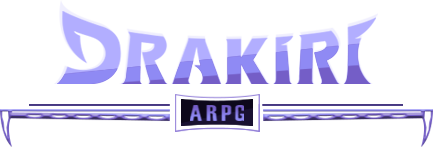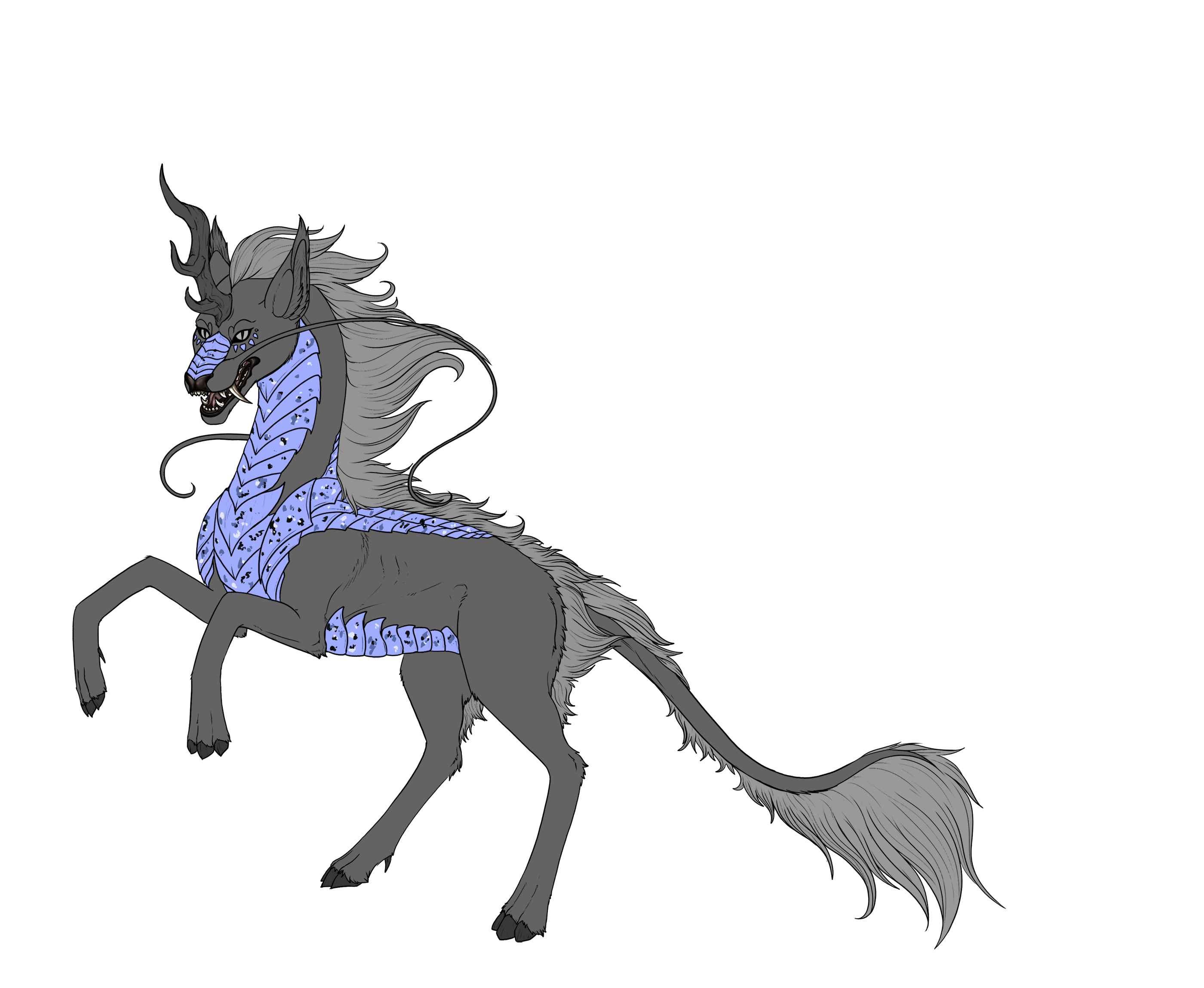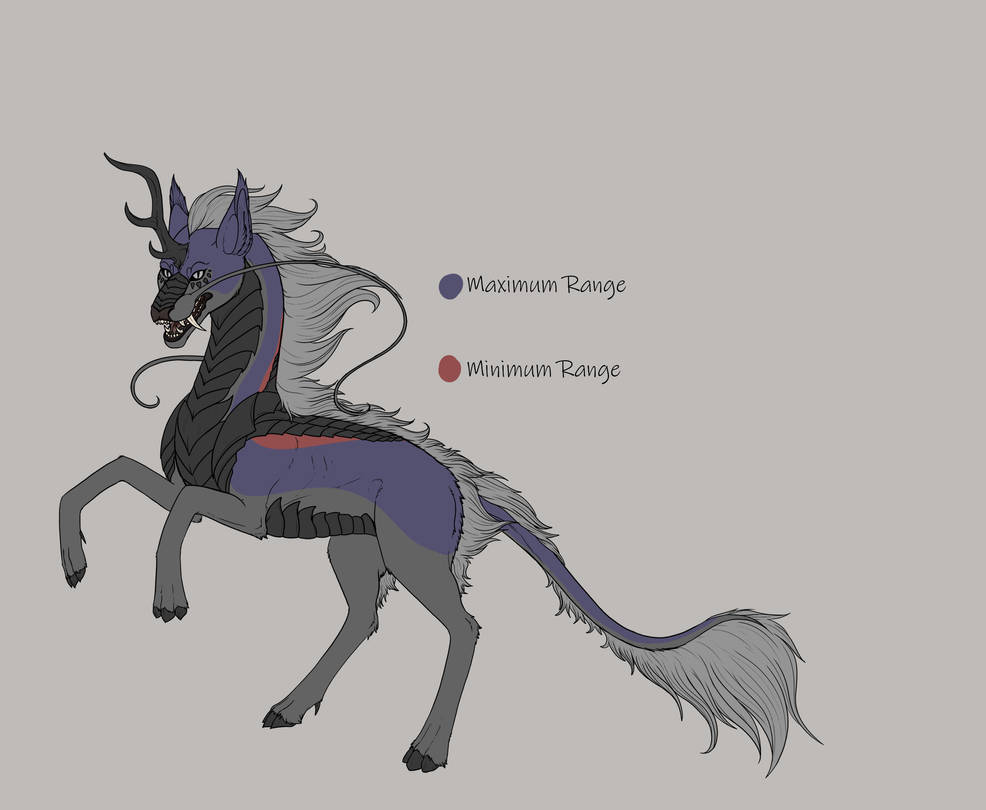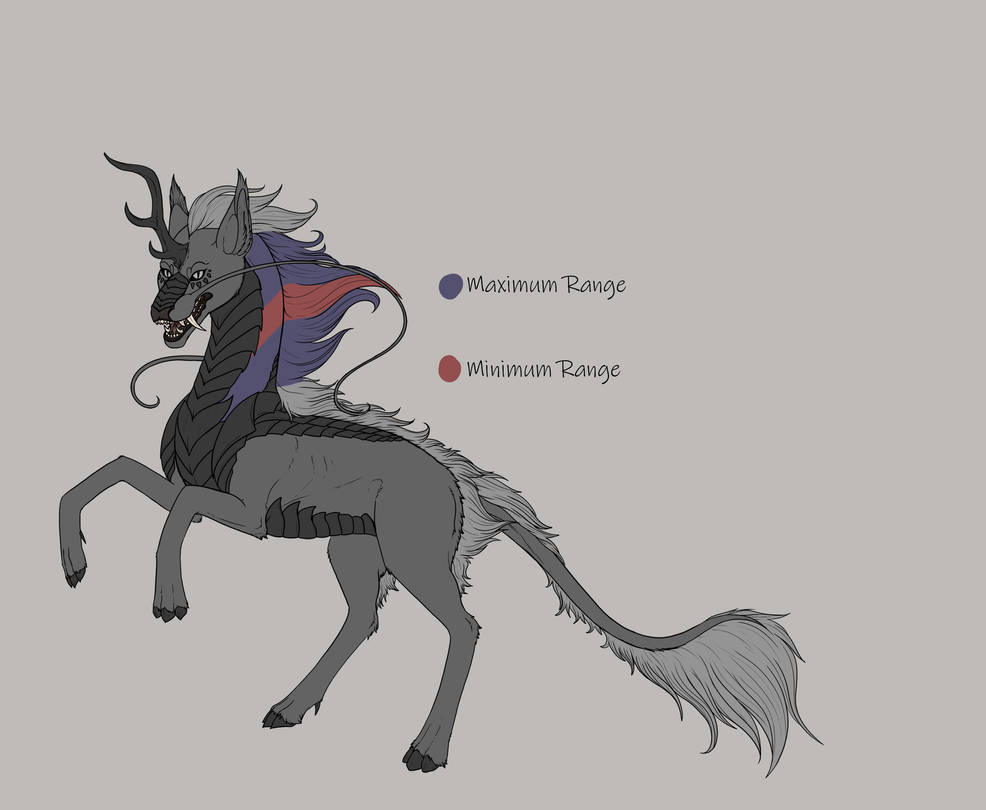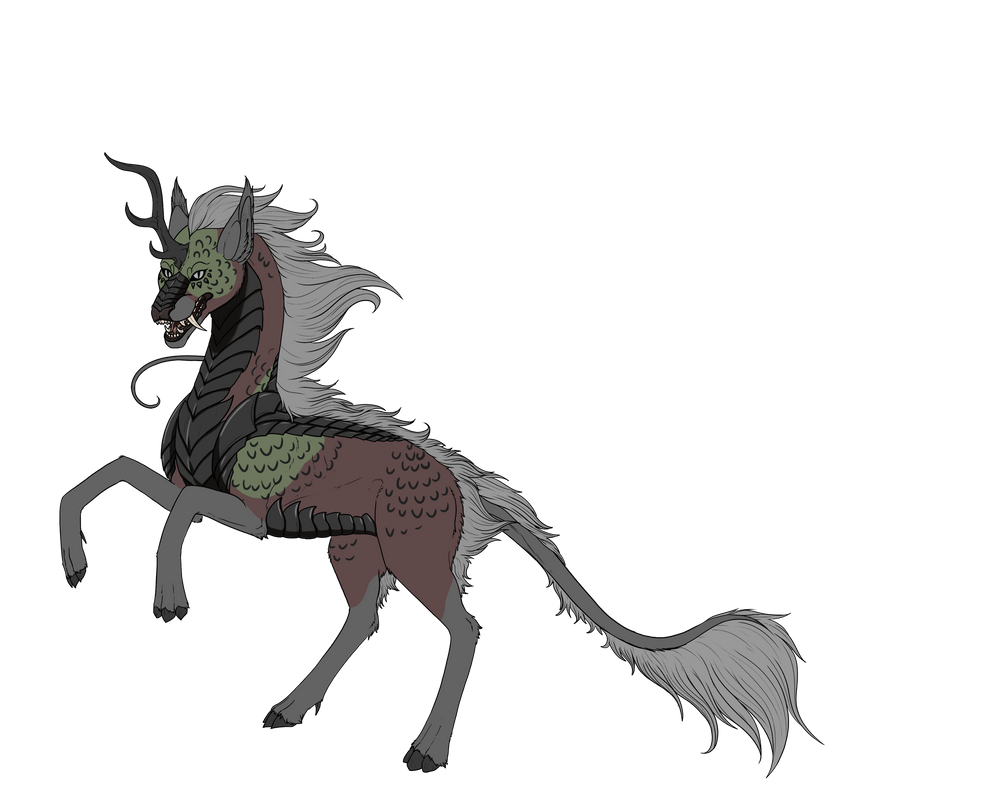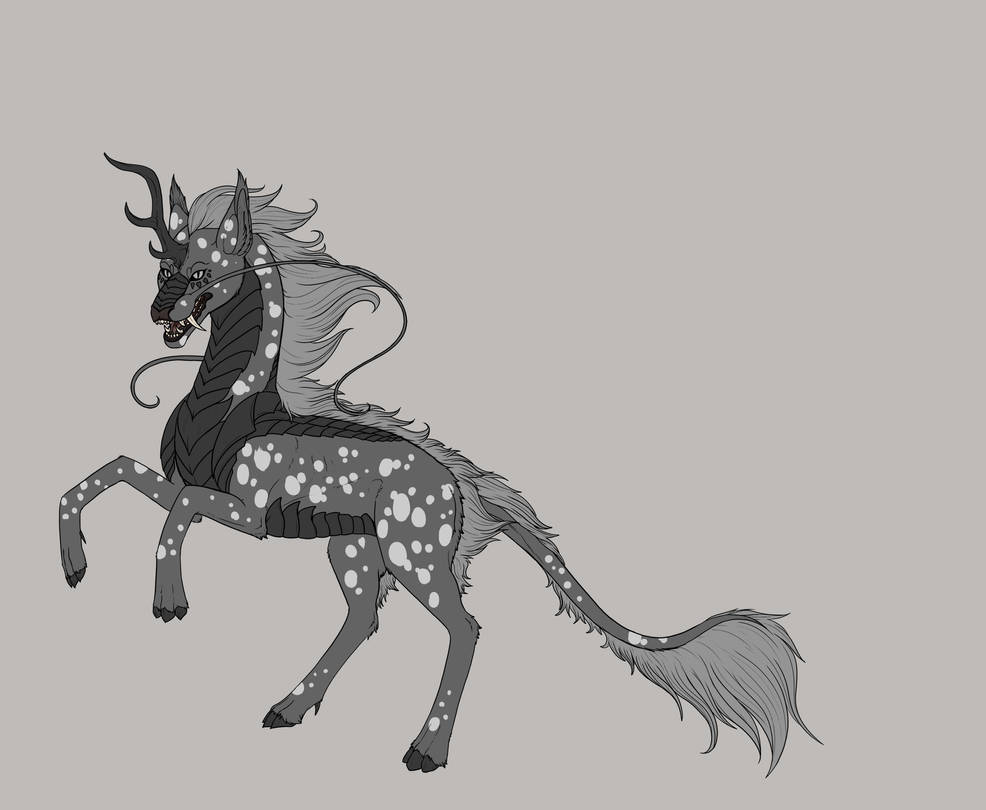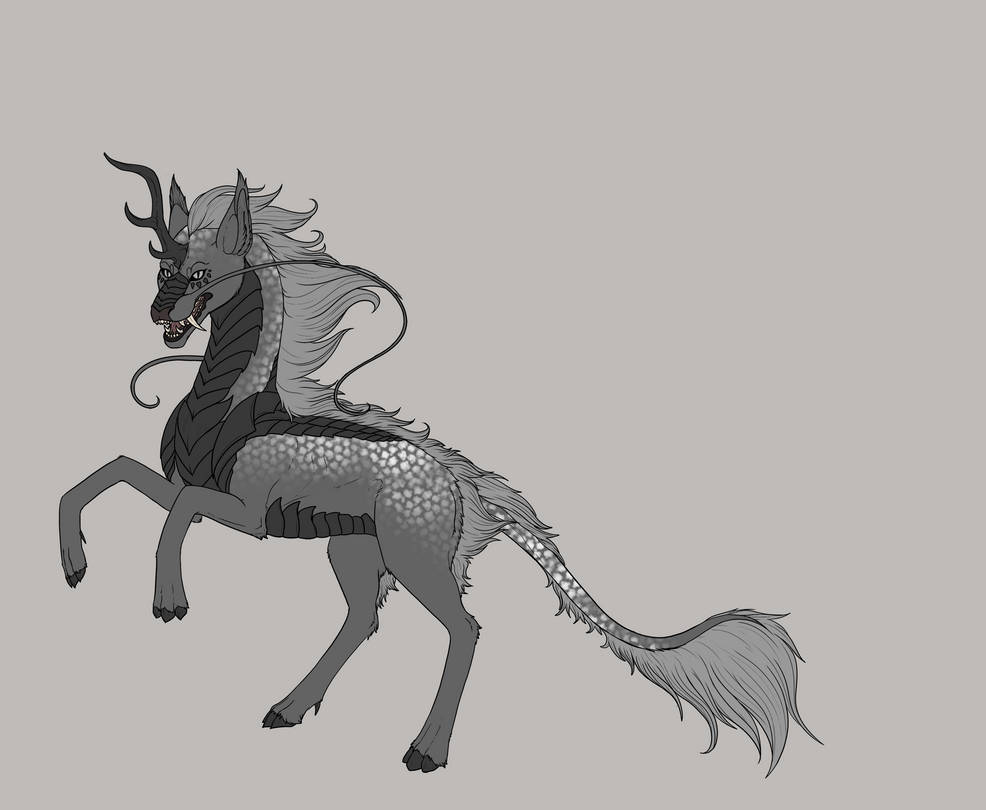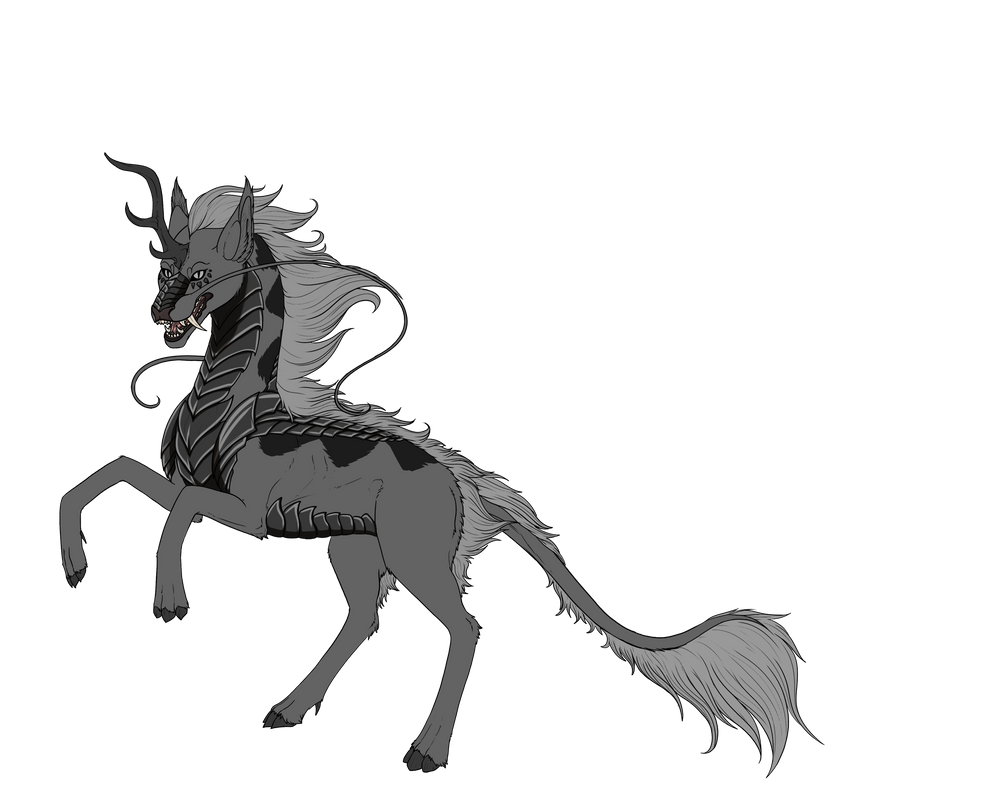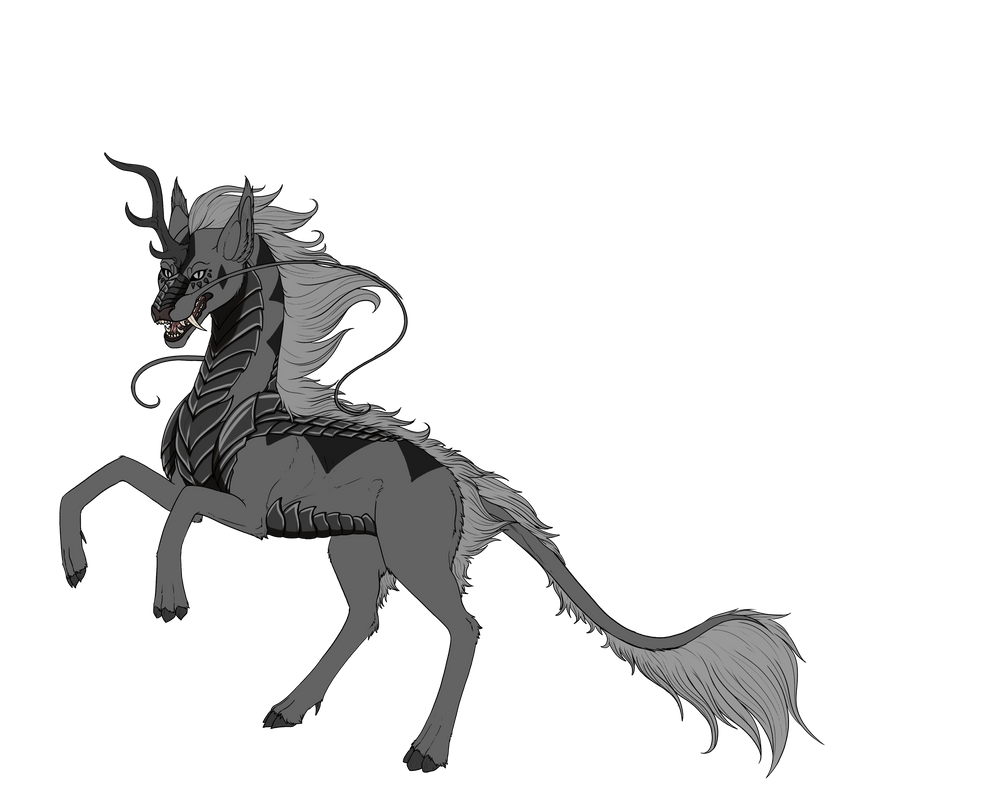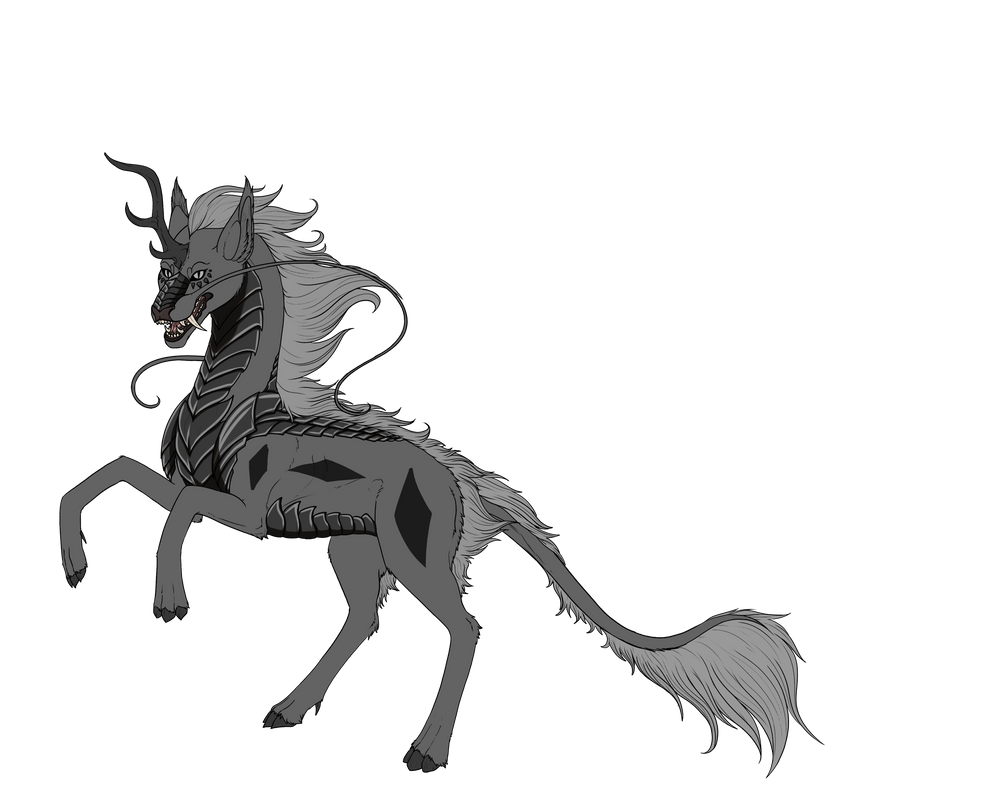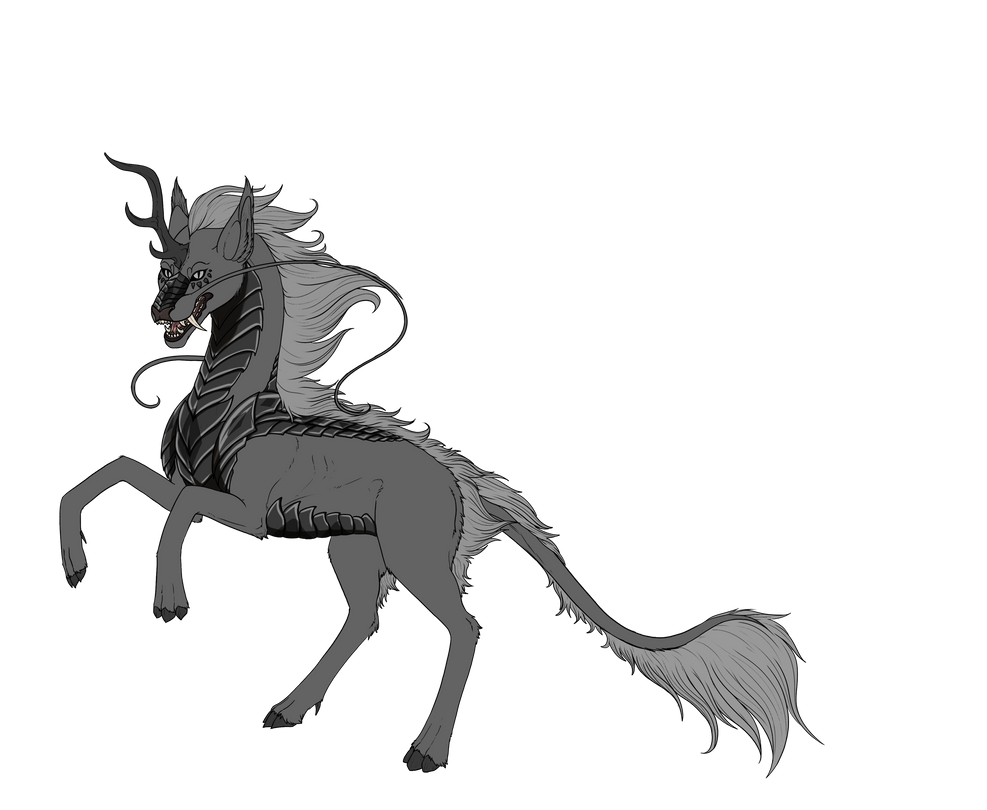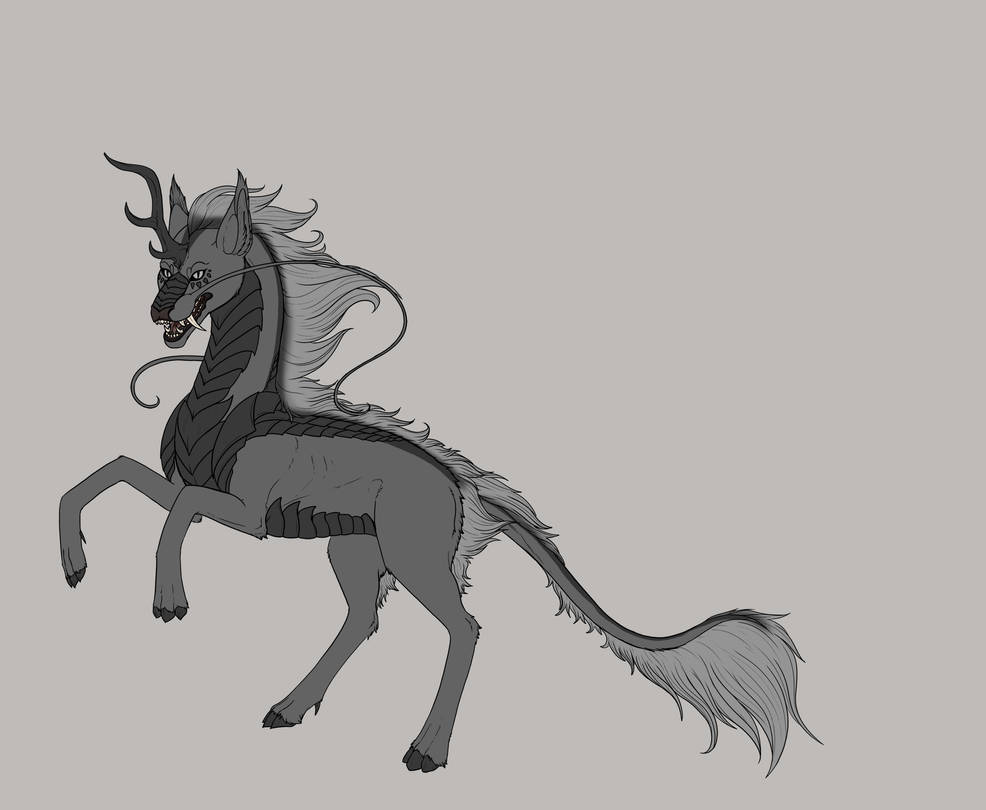Traits
Silver (Common)
Silver is a coat modifier that reduces the saturation of the Drakiri's coat. It doesn't lighten or darken the color, simply desaturates. Silver can be as subtle as a subtle lowering of saturation. If it's not obvious at a glance, mention that you did so in the comments when submitting your geno. Silver can also completely desaturate the Drakiri's coat, or leave hints of color.
Silver can use the palettes in the drive for the base, or you can design the Drakiri as normal and desaturate parts of them or all of them. Only the base coat must be desaturated, meaning all markings are allowed to still have their original saturation as long as it doesn't look too much like Glimmer. Glimmer can appear in full brighteness on Silver, though Silver can also negate the effects of Glimmer if you prefer this.
Note that the palettes in the drive are only a suggestion, and if you have another way you prefer to design your Drakiri, you may use your own method! If in doubt, just explain what you did in the comments, and if it's new and helpful, it will be added to the guides!
Optionally, Silver can give your Drakiri a Perlino effect. The Perlino effect allows the back, shoulders, and parts of the face of the Drakiri to be less saturated, leaving full saturation on the legs, belly, around the mouth, around the eyes, and on the underside of the tail. Of course this range is pretty loose, so have fun! Perlino effect should blend into the brush. Using a saturation layer mask and airbrushing the areas you want desaturated and playing with layer opacity is a very effective way to get this effect!
It is not required to effect the mane and the marking colors are also not required to be effected.
When interacting with Darken or Dilute, there are two options
1- Choose which one you'd like to use.
2 - Combine their effects in fun and creative ways.
Ticked (Common)
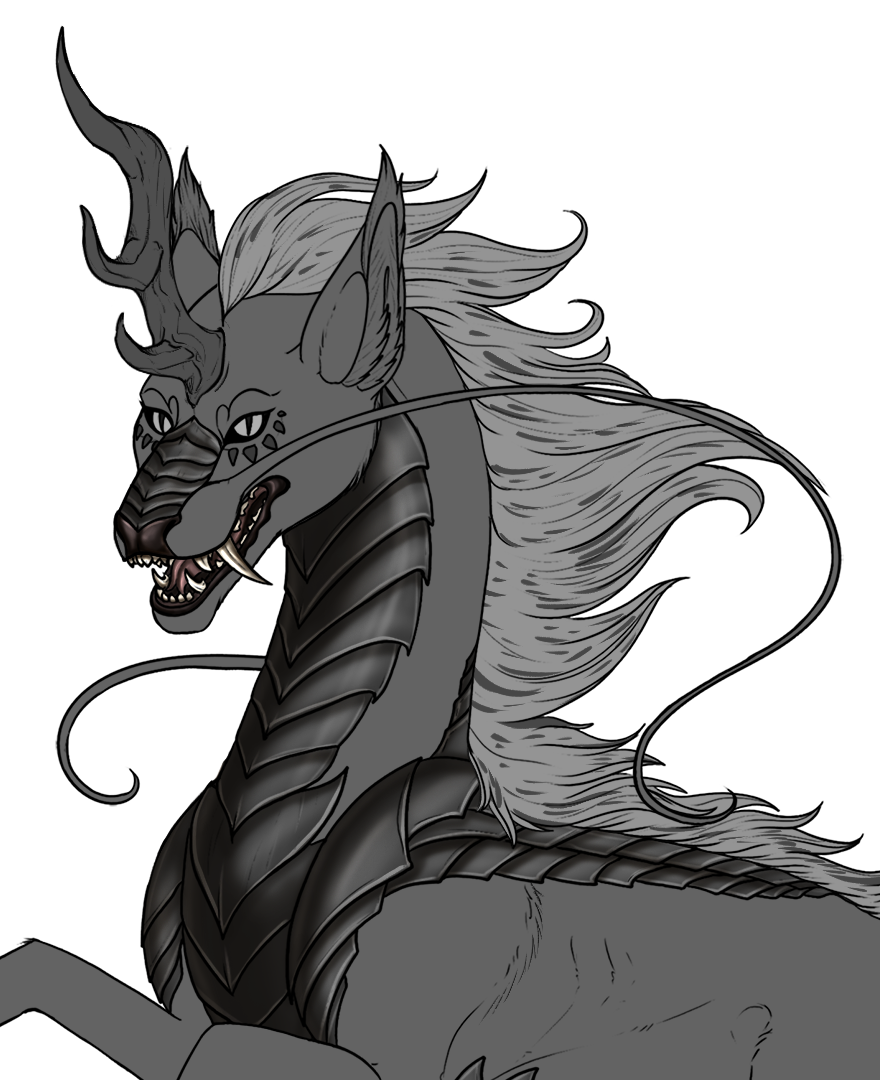
OVERVIEW
- Ticked is a mane specific marking that creates ticking and flecking in the mane and tail fur. Shown above are several examples of what Ticked can do. It can appear as fairly long, so long as it doesn't stretch from the body to the tip of the mane. Ticking can be lighter or darker than the mane beneath it, or a mix of light and dark. It can not too closely resemble Barring or Mane Tips, but it can interact with other mane markings for some really neat effects. How you make it interact is up to you!
RANGE AND DETAILS
- Ticked can only appear in the mane and tail fur. It can not appear on the body or anywhere else.
MIN RANGE
- Just a few tickmarks somewhere in the mane and tail fur
MAX RANGE
- Ticking all over the mane and tail fur.
Flecks (Common)
OVERVIEW
- Flecked is a common marking found on the scales of a Drakiri. Flecked creates various uneven fleck like markings, similar to dalmation jasper or other stones. The example above shows several of the shapes Flecks can take.
RANGE AND DETAILS
- Flecks can appear on any scales on the body, and can also effect the hooves and horn/s. Flecked does not effect the body. On Drakiri with the Smooth mutation, Flecks can either appear on the horns and hooves, or not be visible on the import.
MIN RANGE
- Just a few little flecks somewhere on the scales, or on the hooves and/or horn/s.
MAX RANGE
- Every scale completely covered in the tricolored little markings
Color and Texture
- Flecks can be three shades of the scale color, with bits of white and bits of black in as well. Flecks should be a color relative to the scale color, or various shades of white, grey and black. When on the horns and hooves, Flecks can not reflect the color of the scales without Glimmer. It should then take natural colors, or the very dsaturated scale color if that is used on the horns. Flecks can be textured, and they can bunch together, but they should not be as big as the spots found in Stained or Bleached.
Possible Interactions
- When interacting with Stained or Bleached, it can create much larger splotches in with the flecks, and have flecking form a blend between the dark parts of the scales and the lighter parts. Interacting with Stained or Bleached adds a fourth shade of color to Flecks, interacting with both adds a fifth.
- When interacting with Iridescent scales, Flecks can take on a sparkly shine or metallic look, like bits of crystal or metal in stone.
Some Image inspiration
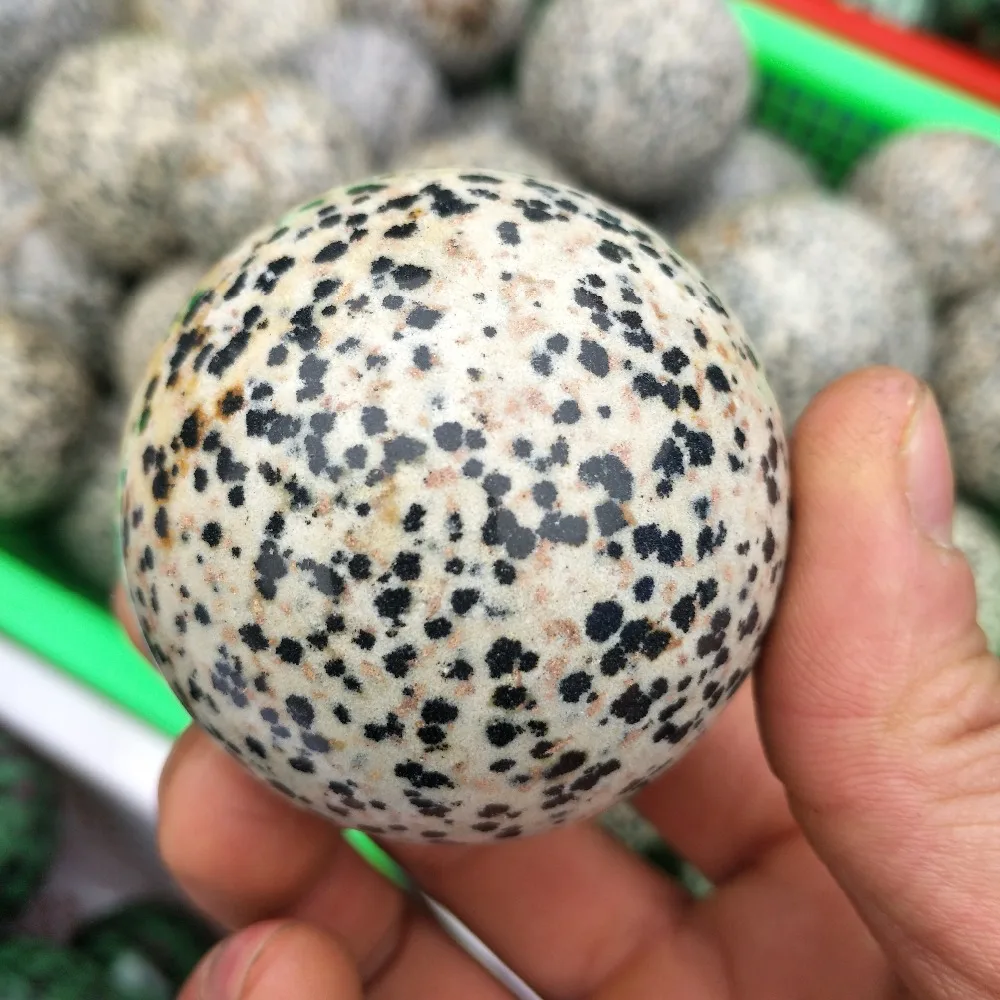

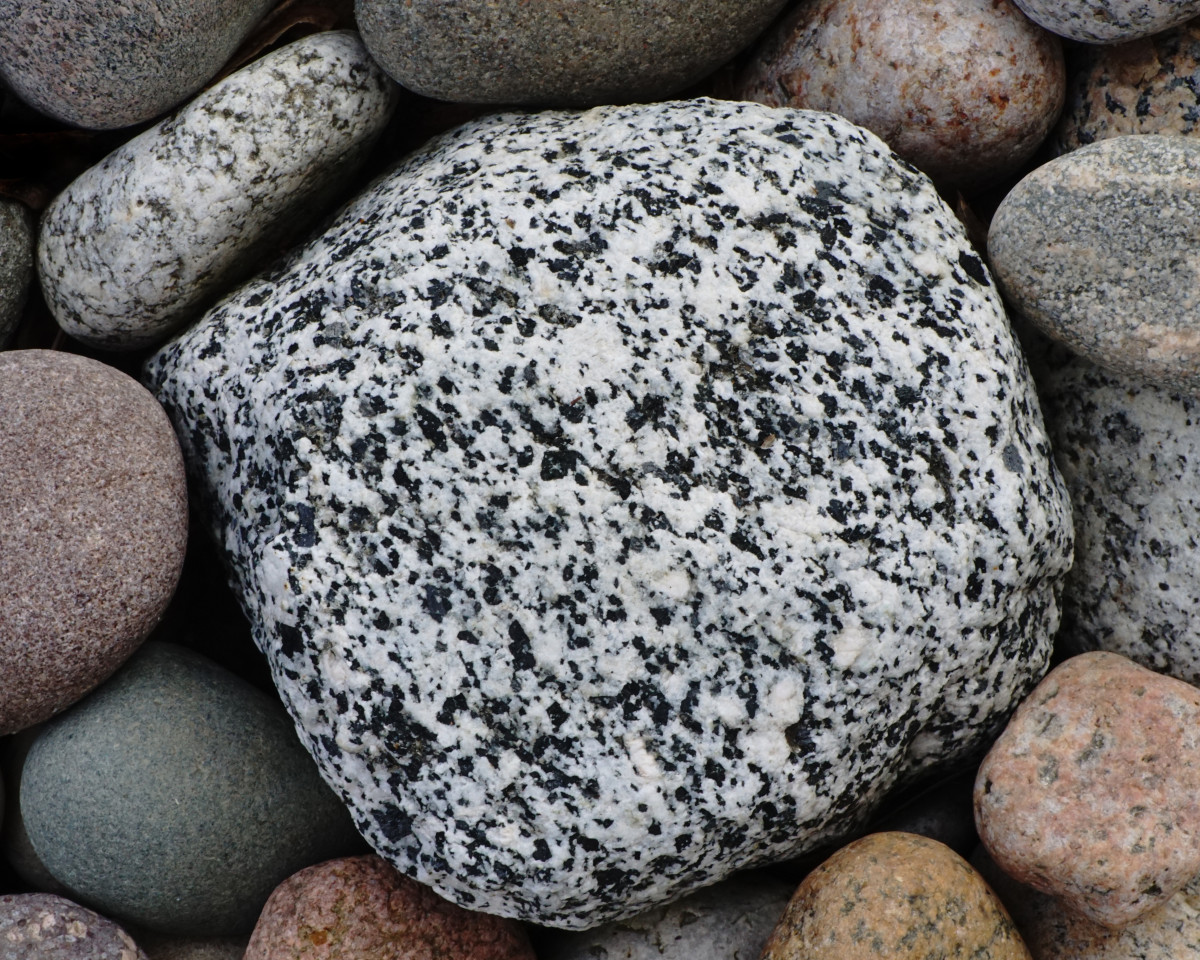
Flare (Common)
This marking is lighter than the base, and can be semisoft edged, or hard edged, or a combination. It effects the forelimbs, but can also effect other markings. It either creates markings that resemble stylized flames on the limbs, face and back, or modifies markings to have edges inspired by stylized flames in shape.
This must be fairly simple; it must not be able to be confused with Comet.
Banding (Common)
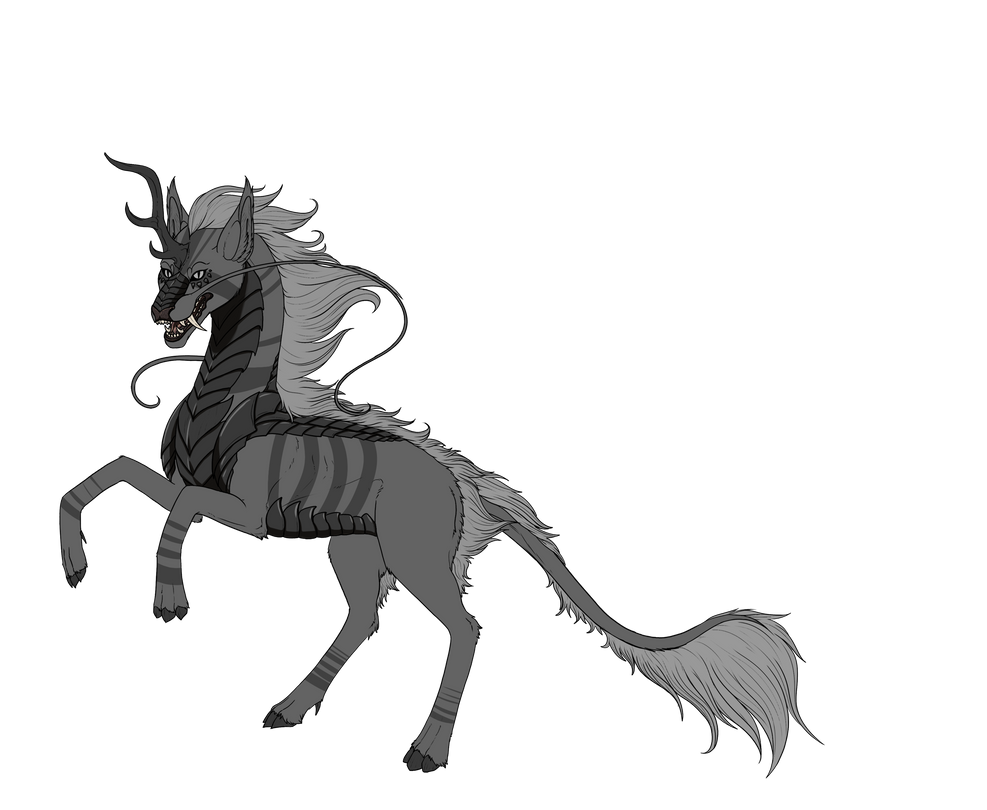
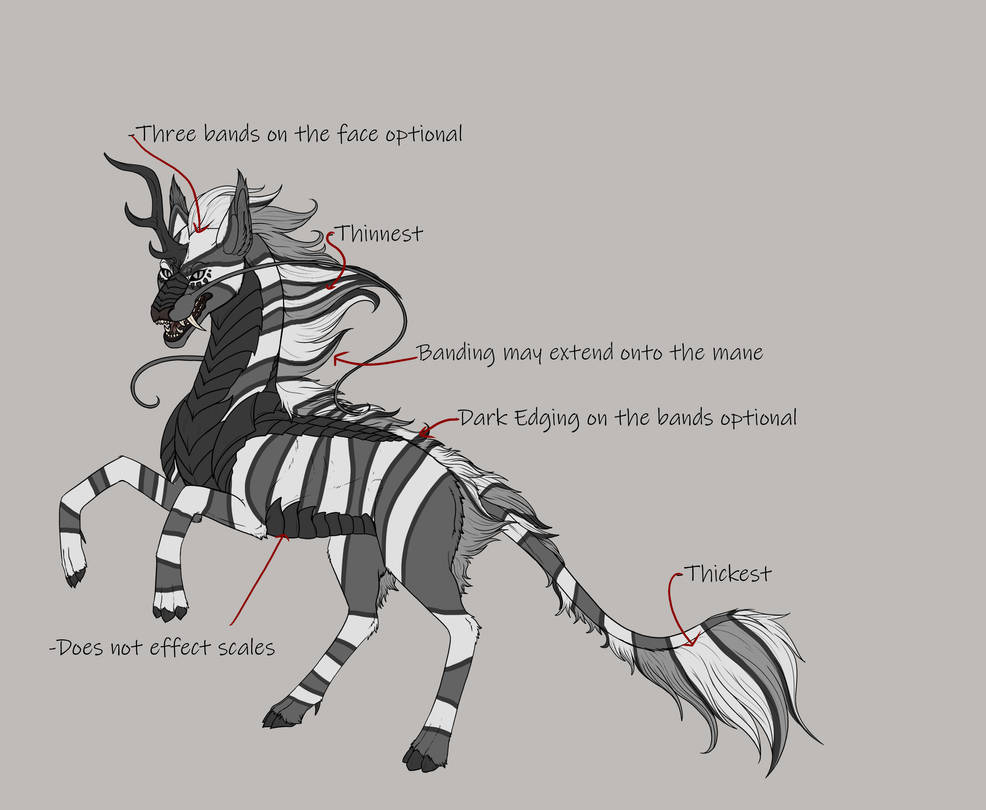
OVERVIEW
- Banding is a full body marking that creates a banded appearance across the body, similar to species such as the clownfish or regal angelfish. The guides for that sort of banding are only needed if you are using the clownfish banding and not the other variations. Banding is either dark, or light with dark rims.
- Alternately, it can resemble the banded marking of a Bongo gazelle around the midsection. When the Bongo version interacts with stripes, it can turn them light without the need for Reversal.
- It can also create small bands on the limbs, or banding like the marks found on falcons on the Drakiri's sides or wings if they have Phoenix. Banding can appear anywhere on the Drakiri's body and ranges from small thin bands on the limbs, to even a single thick band around the midsection.
RANGE AND DETAILS
- Banding has no range and can present anywhere on the Drakiri, but must be present in a noticeable way on the import. Minimally, it can appear on the legs or a couple bands around the midsection. The thickness of the band may taper, and the band shape itself may waver.
- Banding must wrap around wherever it appears on the Drakiri.
- Banding must always be vertical on the Drakiri unless on the legs, then it is horizontal
- As an alternate effect, Banding may form vertical pinstriping along the Drakiri's body
MIN RANGE
- Banding has a Min range of the midsection, face, neck, or legs. Banding does not have to affect the mane, but it can extend onto the mane where it touches.
MAX RANGE
- Full Body coverage, excluding the scales. It can effect the scales where it touches if Marked Scales is present.
SMALLER RIM BANDS
- The outer borders of banding are optional, but if they are shown they must be along the outsides of the bands, and must be significantly thinner than the main light band. They may optionally be on every band on the Drakiri, or only some or even just one of the bands, so long as they're not confused for another marking.
OTHER RANGE INFO
- Banding can affect the Mane and Tail Fur where it touches
- Banding cannot affect the scales unless marked is present in the geno
- Banding is not required to appear on the legs
- Banding is allowed to affect the following mutations
- Banding may effect Pheonix. It can create barring similar to the markings found on the wings of a hawk. If creating the barring effect on the wings, it doesn't have to be present on the body.
Blanket (Common)
BLANKET
OVERVIEW
- Blanket covers the top half of the Drakiri's body in a solid color that is darker than the base coat. When interacting with Sable, it may cover up Sable, or be covered up by Sable, or interact to create a semi soft or semi-blended edges, or some parts blended and some parts hard.
RANGE AND DETAILS
- Blanket is a full back coverage marking that creates a saddle like appearance at is minimum range and a cape like appearance at its maximum range.
MIN RANGE
- Just a little blanket, must at least fill in the red area above.
MAX RANGE
- Blanket can cover the entire back of the Drakiri.
OTHER RANGE INFO
- Blanket does not affect the scales of the Drakiri unless Marked Scales is present.
- Blanket does not affect the mane or tail fur of the Drakiri
COLOR, TEXTURE AND GRADIENT
- Blanket can be any natural color that does not clash with the base coat as long as it is darker, including a black Drakiri. It must be a darker black than the Drakiri itself.
- Blanket is allowed to have a solid textured edge resembling fur strokes
- Blanket cannot be faded, have a gradient, or a soft textured edge. It can get a soft edge of interacting with Pangare, or gain a gradient if effected by the marking Gradient
- Blanket's minimum must be more expansive than Saddle's range - this means that Blanket must, at its absolute minimum, either cover the entire back of the neck, the entire back, or at least part of the legs as well as the shoulders. Blanket is not allowed to restrict to only the shoulder area, to avoid confusion with a dark hard-edged Saddle.
LAYERING AND GAPS/HOLES
- Blanket is a base coat marking, so must other markings layer over it.
PHYSICAL MUTATIONS
- Blanket can affect the following mutations
- Regular base - Marginal Coverts, and quills - Wing Diagram
- Nightmare Base - Top of wing
- Optionally, for ANY base, it may make the entire wing a different color from the body - it must still be a natural-looking color unless Glimmer is present.
- Phoenix
OTHER INFORMATION
- Blanket's textured edge must be fairly simple
- Blanket may not have holes without Cutout
GOOD EXAMPLES
- Coming Soon!
Bleached (Common)

OVERVIEW
- Bleached may make the scales on the Drakiri's back, shoulders, and head a lighter shade of the main scale color - this shade can be noticeably different, so long as it is not a different hue. It does not have to cover all of the scales within its range, and may alternate scales or be soft-edged for this effect.
- Bleached may not use the Scale Spots effect if the scale lightening effect is being used.
The Scale Spots effect of Bleached is otherwise unaffected.
RANGE AND DETAILS
- Bleached is restricted to the scales only, however can be anywhere within those scales so long as some are noticeably visible on the Drakiri.
MIN RANGE
- A few lighter spots on the scales. Can be located anywhere.
- If using the underbelly version, must be present on at least the neck, chest, or belly scales.
MAX RANGE
- Light spotting covering the scales. Can be located anywhere. The scales along the belly and bottom of the neck can all be lighter than the rest, as well, giving an underbelly effect. The bleached scales must be a lighter shade of the scale color used
COLOR AND GRADIENT
- Bleached must be a lighter shade, white, or near white with a hint of the scale color.
- Bleached may be a slightly lower saturation of the scale color, as well as lighter in shade.
-
- Bleached can be affected by Glimmer, Bicolor, Tricolor and Spectrum, but can not be affected by Reversal.
OTHER RANGE INFO
- Bleached does not affect the body.
- Bleached does not affect the mane or tail.
LAYERING AND TEXTURE
- Bleached can layer over or under any other scale specific markings
- Stone or Piebald must both appear over Bleached
GOOD EXAMPLES
Coming Soon
Collar (Common)
COLLAR
OVERVIEW
- Collar is a solid marking on the neck of the Drakiri commonly seen on several species of bird and other animals. It can also be soft edges, creating a gradient on the neck, lighter or darker than the base coat
RANGE AND DETAILS
- A collar-like marking that appears on the neck and mane of the Drakiri, which can cover the entire extent of the neck.
MAX RANGE
- This marking can cover the entire neck in one solid color, optionally affecting the mane wherever it touches.
MIN RANGE
- A single small band around the neck, and may extend into the mane. Similar to a choker necklace.
OTHER RANGE INFO
- Collar is not required to affect the mane wherever it touches unless Collar would be invisible otherwise. If the entire neck is covered by mane, then Collar must affect the mane instead of the neck. Otherwise, it only needs to affect the neck.
- Collar does not affect the scales unless Marked Scales is present in the geno
COLOR TEXTURE AND GRADIENT
- Collar can be any natural color lighter or darker than the base coat so long as it doesn't clash with the base coat color.
- The edges of Collar may be blended into the coat, solid, or given a fur texture.
- Collar may not have gaps or holes unless Cutout is present
- Collar may have a subtle gradient around the middle of the marking. The color of this gradient must be very subtle and it must blend in smoothly with no defined edges.
LAYERING
- Collar can appear above or below any other marking unless stated otherwise.
- Collar must lay below markings such as Piebald and Stone
PHYSICAL MUTATIONS
- Collar affects the following mutations:
- Cobra
GOOD EXAMPLES
Coming Soon
Crescents (Common)
CRESCENTS
OVERVIEW
- Creates feather-like "crescents" on the Drakiri's coat.
RANGE AND DETAILS
- Crescents can appear almost anywhere on the Drakiri's body. It does not affect mane or tail fur.
MIN RANGE
- A few crescents on the face or around the shoulders, or one 'crescent moon' somewhere on the body
MAX RANGE
- Crescents on the entire body
COLOR TEXTURE AND GRADIENT
- Crescents must be darker ot lighter than the coat beneath. It can be affected by Glimmer, Firefly and Gradient.
- Crescents can touch each other, and can take many feather-like shapes, elongated, even slightly pointed as long as they don't too closely resemble Diamond. They can fade into the base coat, but cannot have fades within them.
- Crescents can have small feather-like lines within them.
LAYERING
- Crescents layer over most markings.
PHYSICAL MUTATIONS
- Crescents can trace all the feathers on Phoenix.
GOOD EXAMPLES
Coming Soon
Dapples (Common)
DAPPLES
OVERVIEW
- Light or white spots on the coat of the Drakiri. Dapples must not be bigger than the biggest shown in the above image, nor smaller than the smallest. Big and small spots may touch, but they can not resemble splatters.
RANGE AND DETAILS
- Dapples is a free range spotted-like marking, appearing anywhere on the Drakiri's coat. Often seen on spotted creatures such as the cheetah, but also seen on horse species.
MIN RANGE
- A few spots around the shoulders or hips of the Drakiri.
MAX RANGE
- Dapple-shaped spots appearing on the entire coat of the Drakiri.
ADDITIONAL RANGE INFO
- Dapples does not affect the Scales even when Marked Scales is present
- Dapples does not affect the Mane or Tail Fur
COLOR TEXTURE AND GRADIENT
- Dapples can have the following textures
- Hard Edge or subtle fur texture on the edges. Dapples can also fade into the base coat
- Dapples may resemble horse dapples, fawn dapples, and/or the hard edged light spots.
- This is up to the designer.
- Dapples must remain once consistent color throughout, unless being faded into the base coat or effected by Gradient. If effected by Gradient, both selected shades must be lighter than the base coat
LAYERING
- Dapples may be layered above or below any marking
- Dapples cannot layer above Stone or Piebald
PHYSICAL MUTATIONS
- Dapples may effect the follow mutations
- Phoenix - Entire wing
OTHER INFORMATION
- Dapples can interact with Piebald, staying close to the edges and giving the edge a splotchy appearance.
- When interacting with Piebald, they become white like the Piebald.
- Dapples is not effected by Reversal
GOOD EXAMPLES
Coming Soon
Diamond (Common)
DIAMOND
OVERVIEW
- Creates diamonds on the scales, or diamond shapes on the Drakiri. Also allows arrow shapes along a Drakiri’s body, as minimal as a couple around the eyes, or along the whole body
RANGE AND DETAILS
- Diamond can affect anything aside from the mane
MIN RANGE
- A small diamond somewhere on the Drakiri's body or scales, or a couple "arrows" on the face.
MAX RANGE
- Diamonds all over the body and scales.
OTHER RANGE INFO
- Diamond does not affect the mane or tail fur of the Drakiri
COLOR, TEXTURE AND GRADIENT
- Diamond can't have soft or textured edges. It must be solid, and must resemble a diamond in shape unless using the "Chevrons" or "Arrows" variation.
LAYERING AND GAPS/HOLES
- Diamond can layer above or below any marking unless otherwise specified.
- Diamond must layer beneath Stone and Piebald
PHYSICAL MUTATIONS
- Diamonds and "Arrows" can appear on the wings.
GOOD EXAMPLES
Coming Soon
Dipped (Common)
DIPPED
OVERVIEW
- A marking that covers the rear end or the front end of the Drakiri.
RANGE AND DETAILS
- Dipped may appear on the front end or the back end of the Drakiri, but not both at the same time. Dipped my darken the markings in the areas that it effects. The darkening of the markings must be even with the edge of Dipped, and can not extend past the edge unless Gradient is used to fade them together. A suggestion is to use a layer mask for the Dipped marking if using this method, to allow it to darken what is beneath easily. The Multiply layer type is suggested.
MIN RANGE
- Frontal
- Must cover bare min the entire head
- Rear End
- My change just the tip of the tail, or the fur on the end of the tail
MAX RANGE
- Frontal
- Can extend to the midsection near where the rear leg starts, however it must still cover the head
- Rear end
- Can extend to the midsection of the body origination from the tail. However the tail must still remain fully covered.
ADDITIONAL RANGE INFO
- Dipped does effect the Mane, but is optional
- Dipped does not effect the scales unless marked scales is present
- The legs are not required to be covered, so long as its clear that the marking is still dipped.
- Dipped does effect the whiskers when effecting the front half
COLOR TEXTURE AND GRADIENT
- Dipped must be a darker shade of the base coat unless affected by Reversal
- Dipped may be blended into the coat forming a halfbody gradient. Dipped may only be a single shade throughout.
- Dipped cannot have holes, unless Cutout is present, but may have fur texture and a sway.
- Dipped can only be one shade of consistent color without any gradients unless Gradient is effecting it
LAYERING
- Dipped layers above or below any other markings unless otherwise specified for that marking. (Piebald, Stone and Appaloosa always layer over every other marking)
PHYSICAL MUTATIONS
- Dipped can currently effect the following mutations
- Frontal: Marginal, Secondary, and Primary Covert Feathers and the quills
- Rear End: Primaries, Secondaries, and Tertiary, as well as the greater coverts
- Pheonix -Wing Diagram
OTHER INFORMATION
- Tabby, Brindle, and Striped may restrict to be only present on areas effected by Dipped and fade out with it if the faded version is used
GOOD EXAMPLES
Coming Soon
Dorsal (Common)
DORSAL
OVERVIEW
- A single thin stripe the extends down the back of the Drakiri at an even thickness. It may have small variance in thickness, as in tapering onto the neck or down the back or along the tail
RANGE AND DETAILS
- Dorsal must appear at least on the Drakiri's back. It may fade onto the neck, or fade down the tail, tapering off
MIN RANGE
- At minimum, it appears on the Drakiri itself, and doesn't touch the main
MAX RANGE
- At maximum, it may blend into the mane.
ADDITIONAL INFO
- Dorsal may affect the mane and tail fur
- Dorsal does not affect the scales unless Marked Scales is present
COLOR TEXTURE AND GRADIENT
- Dorsal can be any natural color darker than the base coat of the Drakiri. Dorsal may be dark brown on a black base coat
- Dorsal cannot be blended into the coat, the edge must be solid
- Dorsal must be only one color. No gradient is allowed unless effected by Gradient.
LAYERING
- Dorsal layers over all other markings except the following
- Piebald, Shimmer, Stone, Patches, Frosted and Fleabitten.
PHYSICAL MUTATIONS
- Dorsal can affect the following mutations
- Phoenix - It may line the edges of the wing(s) but must connect to the original marking (no floating Dorsal lines on wings)
GOOD EXAMPLES
Coming Soon
Fade (Common)
Fade
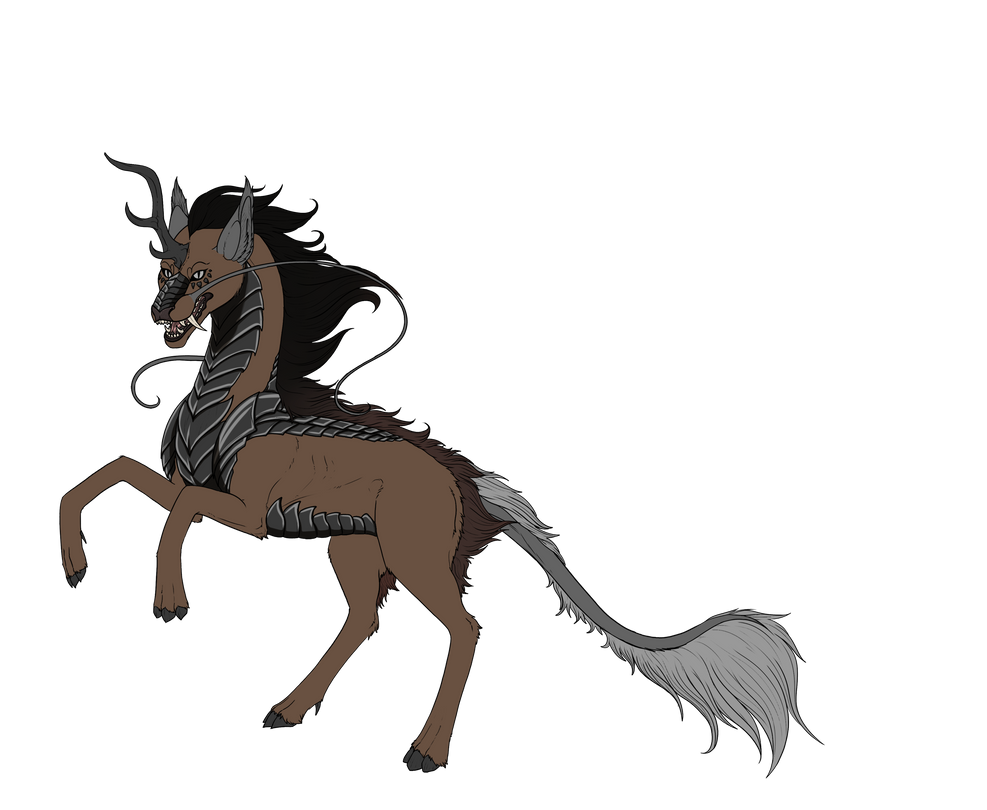
OVERVIEW
- Fade is a mane specific marking, allowing the mane to fade between two different natural colors, front to back. For example a Drakiri with a black mane can have it fade into brown or another natural color towards the back of the Drakiri. The marking on a Drakiri
RANGE AND DETAILS
- Fade restricts to the mane fur, and can not effect anything else. It must be a natural color, and can fade the Vibrant mane color into the base coat if used with Vibrant Mane. Vibrant Mane can also use Fade, however it must fade from one shade of the chosen color to a lighter or darker shade to avoid looking too much like Bicolor unless it is used to fade Vibrant Mane into the natural mane color.
COLOR TEXTURE AND GRADIENT
- Fade must be a natural color unless effected by Vibrant Mane, and then it must be another shade of the color chosen
LAYERING
- Fade must layer beneath markings like Mane Tips and Stroke, however it can interact with Mane Tips, allowing the fade to taper onto the rest of the mane
PHYSICAL MUTATIONS
- Fade does not effect any physical mutations
GOOD EXAMPLES
Coming Soon!
